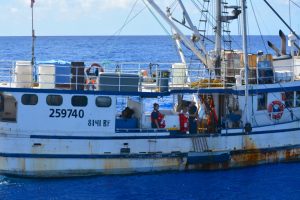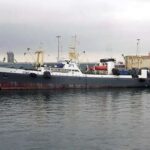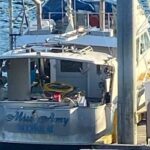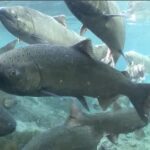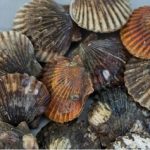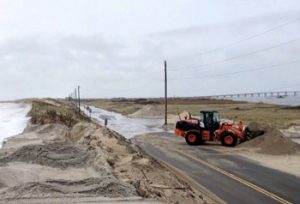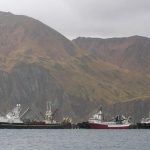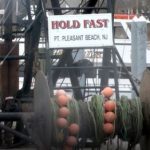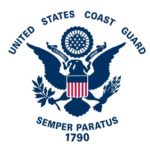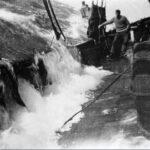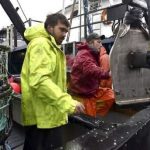Daily Archives: December 6, 2016
Video: Coast Guard responds to fishing vessel’s may day call near Martha’s Vineyard
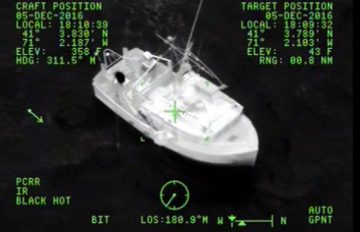 Coast Guard crews escorted a disabled 47-foot fishing vessel to safety Monday evening into Tuesday morning from 30 miles south of Martha’s Vineyard. The fishing vessel Pilgrim became disabled after its mast broke and was left hanging over the side. Coast Guard watchstanders at Sector Southeastern New England were notified Monday at around 4:30 p.m. by Pilgrim’s captain via marine radio of the situation. An MH-60 Jayhawk helicopter crew from Coast Guard Air Station Cape Cod launched and was able to locate the vessel based off Pilgrim’s may day call. After locating Pilgrim, the helicopter crew remained on scene until Coast Guard Cutter Albacore arrived to take over. The Albacore stayed with Pilgrim until Pilgrim’s sister ship, Shamrock, arrived Tuesday morning and was able to help the Pilgrim crew make repairs at sea. Watch video here 16:54
Coast Guard crews escorted a disabled 47-foot fishing vessel to safety Monday evening into Tuesday morning from 30 miles south of Martha’s Vineyard. The fishing vessel Pilgrim became disabled after its mast broke and was left hanging over the side. Coast Guard watchstanders at Sector Southeastern New England were notified Monday at around 4:30 p.m. by Pilgrim’s captain via marine radio of the situation. An MH-60 Jayhawk helicopter crew from Coast Guard Air Station Cape Cod launched and was able to locate the vessel based off Pilgrim’s may day call. After locating Pilgrim, the helicopter crew remained on scene until Coast Guard Cutter Albacore arrived to take over. The Albacore stayed with Pilgrim until Pilgrim’s sister ship, Shamrock, arrived Tuesday morning and was able to help the Pilgrim crew make repairs at sea. Watch video here 16:54
Fishing company Sanford Limited rails against Hauraki Gulf “Sea Change” plan
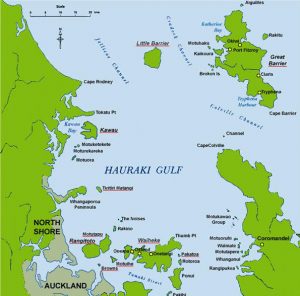 The plan called Sea Change -Tai Timu Tai Pari was unveiled in Auckland last night and suggests a blueprint to tackle growing problems like depleted seafood stocks, sediment damage and pressure from population growth around the gulf. Four years in the making, the collaborative blueprint consulted 14 community and governmental groups to find a way to improve the health and sustainability of the Hauraki Gulf. To reverse declining fish stocks it wants to phase out fishing methods such as trawling, Danish Seining, set netting and dredging. It suggests commercial fishing companies should instead concentrate on producing higher-quality fish, caught using long-lines. The fishing company Sanford is the biggest fisher in the area holding about 40 percent of the quotas in the Hauraki Gulf. The recommendations in the plan were based on emotions, not science, Sanford chief executive Volker Kuntzsch said. Read the story here 16:21
The plan called Sea Change -Tai Timu Tai Pari was unveiled in Auckland last night and suggests a blueprint to tackle growing problems like depleted seafood stocks, sediment damage and pressure from population growth around the gulf. Four years in the making, the collaborative blueprint consulted 14 community and governmental groups to find a way to improve the health and sustainability of the Hauraki Gulf. To reverse declining fish stocks it wants to phase out fishing methods such as trawling, Danish Seining, set netting and dredging. It suggests commercial fishing companies should instead concentrate on producing higher-quality fish, caught using long-lines. The fishing company Sanford is the biggest fisher in the area holding about 40 percent of the quotas in the Hauraki Gulf. The recommendations in the plan were based on emotions, not science, Sanford chief executive Volker Kuntzsch said. Read the story here 16:21
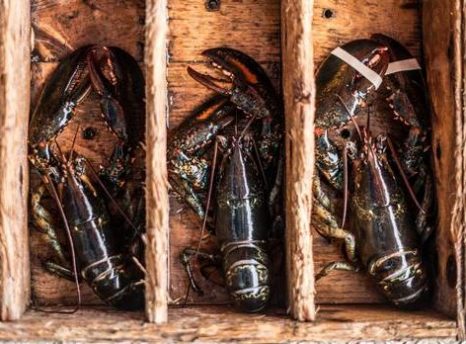
Pinched! Why Canadian Lobster in Unaffordable to most Canadians
The lobster salad at Toronto’s Nota Bene has been on the menu since George Bush’s son was U.S. president (that is, 2008). So when the dish of steamed Nova Scotia lobster, maple-smoked bacon, preserved dill, avocado and buttermilk ranch dressing disappeared in early fall, regulars noticed. Servers told querying patrons that the quality of lobster was not up to par. The harder truth was that the crustacean had gotten too rich for our blood. In the past five years, co-owner David Lee watched per-pound cost rise from around $9 to $12. Even if Nota Bene charged $29 for the appetizer, the dish would be unprofitable. “The price is just crazy,” Lee says. “And there’s only so much the guest will pay for lobster.” When it reached $16 a pound in September, he took the salad off the menu. People love to tell you, with the fanfare of revealing that Michael Caine’s real name is Maurice Micklewhite, that lobster was once so inexpensive and undesirable that it was fed to servants and prisoners. However, this is not back in the day. And to anyone fewer than 100 years old and not living on the Atlantic, lobster is a delicacy. Read the story here 13:34
Santa Cruz crabbers face a slow start to the season
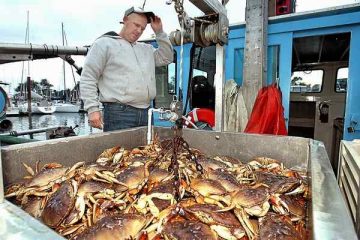 Three weeks into commercial crab season, Santa Cruz harbor fishermen are having a tough time finding crabs. “The season in Santa Cruz has been pretty slow,” said Hans Haveman of H&H Fresh Fish, a wholesale and retail fish seller at the harbor. “There’s crabs coming in, but not nearly in the numbers we would like or that we’d seen in the past few years.” The harbor has 15 to 20 active commercial crab boats that fish for the wildly popular Dungeness crab along with the less famous rock and spider crab, according to the Santa Cruz harbormaster. Three weeks into the season last year, each boat was bringing in an average of 800 to 1,000 pounds of crab a day, but this year that number has plummeted to about 100 to 200 pounds a day. “We don’t really know what’s going on,” Haveman said, who buys crabs from nine boats. Read the story here 11:13
Three weeks into commercial crab season, Santa Cruz harbor fishermen are having a tough time finding crabs. “The season in Santa Cruz has been pretty slow,” said Hans Haveman of H&H Fresh Fish, a wholesale and retail fish seller at the harbor. “There’s crabs coming in, but not nearly in the numbers we would like or that we’d seen in the past few years.” The harbor has 15 to 20 active commercial crab boats that fish for the wildly popular Dungeness crab along with the less famous rock and spider crab, according to the Santa Cruz harbormaster. Three weeks into the season last year, each boat was bringing in an average of 800 to 1,000 pounds of crab a day, but this year that number has plummeted to about 100 to 200 pounds a day. “We don’t really know what’s going on,” Haveman said, who buys crabs from nine boats. Read the story here 11:13
Commercial cod fishermen get more space in Kachemak Bay
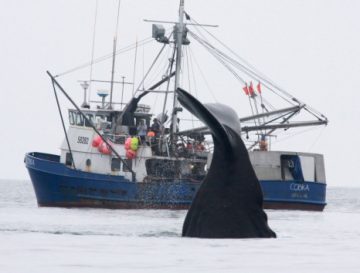 Commercial groundfish fishermen in Kachemak Bay will get more space to operate after the Board of Fisheries redefined the closed waters in the area. In Lower Cook Inlet, commercial fishermen are allowed to use pots to fish for Pacific cod and have been allowed inside Kachemak Bay west of the Homer Spit and along the southern shore of the bay near Seldovia. However, the main section and a swath extending westward in the center of the bay have been closed by regulation because of concerns for the Tanner crab population, which has dropped off significantly in Kachemak Bay in the last two decades or so. The fishery is mostly small boats, and because the fishery takes place in the fall on the edges of Kachemak Bay, they run the risk of bad weather, so to avoid the poor weather, they have limited area, said AlRay Carroll, the proposer, during his public comments during the Board of Fisheries’ meeting in Homer on Wednesday. Read the article here 10:28
Commercial groundfish fishermen in Kachemak Bay will get more space to operate after the Board of Fisheries redefined the closed waters in the area. In Lower Cook Inlet, commercial fishermen are allowed to use pots to fish for Pacific cod and have been allowed inside Kachemak Bay west of the Homer Spit and along the southern shore of the bay near Seldovia. However, the main section and a swath extending westward in the center of the bay have been closed by regulation because of concerns for the Tanner crab population, which has dropped off significantly in Kachemak Bay in the last two decades or so. The fishery is mostly small boats, and because the fishery takes place in the fall on the edges of Kachemak Bay, they run the risk of bad weather, so to avoid the poor weather, they have limited area, said AlRay Carroll, the proposer, during his public comments during the Board of Fisheries’ meeting in Homer on Wednesday. Read the article here 10:28
Crescent City Harbor District sues fishing vessel owner
 The Crescent City Harbor District has filed a lawsuit against the owner of a fishing vessel, alleging that he owes more than $8,747.48 in unpaid berthing fees and late fees. The district filed a complaint on Nov. 23 in the U.S. District Court for the Northern District of California against John F. Marques and his fishing vessel, F/V Chelsea. The F/V Chelsea is a 47-year-old fiberglass commercial fishing vessel measuring 40-feet in length and whose hailing port is Crescent City. The Chelsea was still at the harbor when the complaint was filed. Marques entered into a berthing and rental agreement with the Harbor in October 2009. A second agreement was signed in November 2011 and a third agreement reached in February 2014. Marques began falling behind on his berthing fees in summer 2013, according to the complaint. Read the rest here 10:21
The Crescent City Harbor District has filed a lawsuit against the owner of a fishing vessel, alleging that he owes more than $8,747.48 in unpaid berthing fees and late fees. The district filed a complaint on Nov. 23 in the U.S. District Court for the Northern District of California against John F. Marques and his fishing vessel, F/V Chelsea. The F/V Chelsea is a 47-year-old fiberglass commercial fishing vessel measuring 40-feet in length and whose hailing port is Crescent City. The Chelsea was still at the harbor when the complaint was filed. Marques entered into a berthing and rental agreement with the Harbor in October 2009. A second agreement was signed in November 2011 and a third agreement reached in February 2014. Marques began falling behind on his berthing fees in summer 2013, according to the complaint. Read the rest here 10:21
Crewman tells of harrowing escape from sinking Alaska Juris
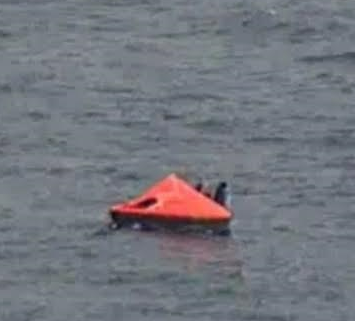 The evacuation and rescue of the crew of 46 from the sinking Alaska Juris was accomplished without any deaths or serious injuries. But crewman Aaron Hell experienced tense moments as he briefly fell into the chill Bering Sea while trying to climb down a ladder along the side of the sinking vessel and board a life raft. During afternoon testimony, Hell described a multinational crew aboard the Alaska Juris that included Japanese, Mexicans and recruits from African nations. He said they all had to find a way to work together to enable operation of the Alaska Juris, an aging vessel built in the 1970s that motors off to remote locations to catch, process and freeze fish. Read the story here 08:27
The evacuation and rescue of the crew of 46 from the sinking Alaska Juris was accomplished without any deaths or serious injuries. But crewman Aaron Hell experienced tense moments as he briefly fell into the chill Bering Sea while trying to climb down a ladder along the side of the sinking vessel and board a life raft. During afternoon testimony, Hell described a multinational crew aboard the Alaska Juris that included Japanese, Mexicans and recruits from African nations. He said they all had to find a way to work together to enable operation of the Alaska Juris, an aging vessel built in the 1970s that motors off to remote locations to catch, process and freeze fish. Read the story here 08:27
Don’t bite on risky lure of ‘catch shares’
 I can’t think of a more appropriate saying to use than “a wolf in sheep’s clothing” to describe the reality of what the Seafood Harvesters of America want to do with our offshore fisheries. The Post and Courier recently published an article and editorial that bought into the sheep’s clothing side. Year-round fishing and better fisheries data are touted. Who could be against that? But there’s a wolf: privatization of our fisheries through a scheme called “catch shares,” where fishermen and corporations are actually given ownership of our fisheries with shares that can be bought or sold like stock on Wall Street. That’s the real reason for the Seafood Harvesters of America’s existence. They’re working hard to ensure commercial fishermen own our fisheries, and in this case it’s our snapper and grouper, starting with a pilot program that could be considered by the South Atlantic Fishery Management Council and NOAA Fisheries next year. Read the op-ed here 08:02
I can’t think of a more appropriate saying to use than “a wolf in sheep’s clothing” to describe the reality of what the Seafood Harvesters of America want to do with our offshore fisheries. The Post and Courier recently published an article and editorial that bought into the sheep’s clothing side. Year-round fishing and better fisheries data are touted. Who could be against that? But there’s a wolf: privatization of our fisheries through a scheme called “catch shares,” where fishermen and corporations are actually given ownership of our fisheries with shares that can be bought or sold like stock on Wall Street. That’s the real reason for the Seafood Harvesters of America’s existence. They’re working hard to ensure commercial fishermen own our fisheries, and in this case it’s our snapper and grouper, starting with a pilot program that could be considered by the South Atlantic Fishery Management Council and NOAA Fisheries next year. Read the op-ed here 08:02

































